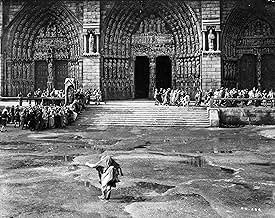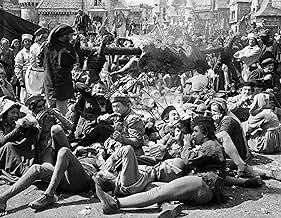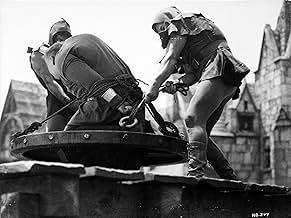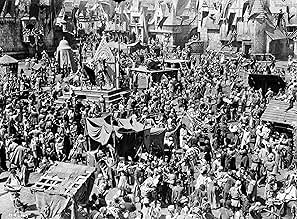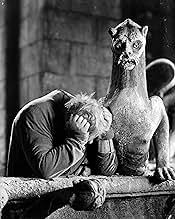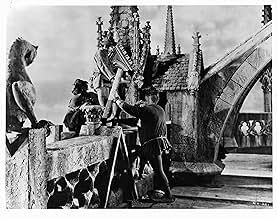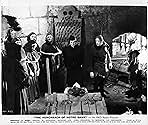ÉVALUATION IMDb
7,8/10
13 k
MA NOTE
Dans la France du XVe siècle, une gitane est accusée de meurtre par le juge en chef enthousiasmé et seul le sonneur de la cathédrale Notre-Dame peut la sauver.Dans la France du XVe siècle, une gitane est accusée de meurtre par le juge en chef enthousiasmé et seul le sonneur de la cathédrale Notre-Dame peut la sauver.Dans la France du XVe siècle, une gitane est accusée de meurtre par le juge en chef enthousiasmé et seul le sonneur de la cathédrale Notre-Dame peut la sauver.
- Director
- Writers
- Stars
- Nommé pour 2 oscars
- 1 victoire et 2 nominations au total
Cedric Hardwicke
- Frollo
- (as Sir Cedric Hardwicke)
Helene Reynolds
- Fleur de Lys
- (as Helene Whitney)
Minna Gombell
- Queen of Beggars
- (as Mina Gombell)
Rod La Rocque
- Phillippe
- (as Rod LaRocque)
Avis en vedette
A sweeping claim? Perhaps. But despite the presence in Hollywood over sixty subsequent years of Ford, Wyler, Kubrick, Coppola, Scorsese et al, The Hunchback of Notre Dame remains as fresh, as emotionally resonant and yes as powerfully artistic as the day it was made. What constitutes 'art' is of course a personal matter, just as the Breughel-like compositions of Hunchback might be as mystifying to someone whose favourite film is A Clockwork Orange (Lichtenstein?). But what makes Hunchback so satisfying as art is precisely that its makers didn't set out with art in mind. Dieterle and his co-creators embarked on the project with the aim of telling a great yarn, making it look authentic, and above all ENTERTAINING the audience. It is to this end that the Grand Guignol excesses of the novel were trimmed or altered, and the Hollywood bittersweet ending imposed. Audiences filed out with their Kleenex in hand having witnessed a three-ring circus of a movie, then went home to read the war-soaked newspapers.
Virtually every frame of this movie could be taken in isolation, made into a poster and hung on a wall. Examples include Gringoire cradling the dying Clopin as a rivulet of lead trickles past in the background, the voyeuristic eye of Quasimodo peering through fence palings at the dancing Esmeralda - I could go on and on. And pervading it all is the magnificent score of Alfred Newman, surely his finest ever.
Rather than sing its obvious praises, the film can simply speak for itself. As narrative, as character, as cinema craft, it is totally successful throughout. The Hunchback of Notre Dame is my favourite film of all time, bar none. Ten out of ten
Virtually every frame of this movie could be taken in isolation, made into a poster and hung on a wall. Examples include Gringoire cradling the dying Clopin as a rivulet of lead trickles past in the background, the voyeuristic eye of Quasimodo peering through fence palings at the dancing Esmeralda - I could go on and on. And pervading it all is the magnificent score of Alfred Newman, surely his finest ever.
Rather than sing its obvious praises, the film can simply speak for itself. As narrative, as character, as cinema craft, it is totally successful throughout. The Hunchback of Notre Dame is my favourite film of all time, bar none. Ten out of ten
The ending differs from Hugo's novel,but I guess it was necessary to bestow on the audiences a de rigueur happy end when the world situation was getting worse and worse.It' s also dubious that king Louis XI -who died in 1483- might have been aware of Christophe Colomb's plans ,because the latter only informed the king of Portugal-who refused to put up the money for his expedition- in ...1484!
These are minor squabbles.Because this movie is definitely the finest version of Hugo's classic ,much superior to the French one ,directed by Jean Delannoy(1956) with Anthony Quinn and Gina Lollobrigida.Dieterle's work is a feast for the eyes with numerous classic scenes ,very clever dialogue,superlative performances and complete mastery of the camera.
The opening-Louis XI visiting a printing house-sums up the turning of history:Gutenberg's invention will allow the knowledge and as the King watches the cathedrals ,he makes us feel that these books of stone are fast becoming a thing of the past.The Middle Ages are coming to an end,but a lot of people ,particularly the clergy do not want to lose the power they have on the populace.When Frollo sentences Esmeralda to death,because of his sexual desire,he puts the blame on the devil.He's a man of the past,diametrically opposite to Gringoire,who epitomizes modernity,and who understands the power of the pamphlet which the printing increases tenfold.
Charles Laughton is by far the best Quasimodo that can be seen on a screen:he's so extraordinary that he almost turns the happy end into a tragedy!He gets good support from a moving and extremely beautiful O'Hara as Esmeralda and from Harwicke as Frollo.
Peaks:the fools day,the cour des miracles -maybe showing some influence by Browning's "freaks"-,all the scenes in the cathedral.Dieterle is on par with the most demanding directors all along his movie:the movements in the crowd are stunning,breathtaking,often filmed from the church towers.Humor is not absent either:Gregoire's eventful night in the cour des Miracles is colorful and funny and scary all at once.
A monument,like the cathedral itself.
These are minor squabbles.Because this movie is definitely the finest version of Hugo's classic ,much superior to the French one ,directed by Jean Delannoy(1956) with Anthony Quinn and Gina Lollobrigida.Dieterle's work is a feast for the eyes with numerous classic scenes ,very clever dialogue,superlative performances and complete mastery of the camera.
The opening-Louis XI visiting a printing house-sums up the turning of history:Gutenberg's invention will allow the knowledge and as the King watches the cathedrals ,he makes us feel that these books of stone are fast becoming a thing of the past.The Middle Ages are coming to an end,but a lot of people ,particularly the clergy do not want to lose the power they have on the populace.When Frollo sentences Esmeralda to death,because of his sexual desire,he puts the blame on the devil.He's a man of the past,diametrically opposite to Gringoire,who epitomizes modernity,and who understands the power of the pamphlet which the printing increases tenfold.
Charles Laughton is by far the best Quasimodo that can be seen on a screen:he's so extraordinary that he almost turns the happy end into a tragedy!He gets good support from a moving and extremely beautiful O'Hara as Esmeralda and from Harwicke as Frollo.
Peaks:the fools day,the cour des miracles -maybe showing some influence by Browning's "freaks"-,all the scenes in the cathedral.Dieterle is on par with the most demanding directors all along his movie:the movements in the crowd are stunning,breathtaking,often filmed from the church towers.Humor is not absent either:Gregoire's eventful night in the cour des Miracles is colorful and funny and scary all at once.
A monument,like the cathedral itself.
Charles Laughton's boisterous portrayal of Quasimodo and Maureen O'Hara's charm as Esmerelda are two of the things that make this version of "The Hunchback of Notre Dame" a fine production that still works very well. Most of the versions of the story have been at least watchable, because the Victor Hugo novel provides so much good material to work with, much of it well-suited for cinema. This adaptation, though, is one of the best at making good use of what it offers.
It's interesting to compare this picture with the 1923 Lon Chaney version - not for the sake of ranking them, since both are fully worthy of attention in their own right, but because they offer somewhat different strengths, and because they emphasize somewhat different aspects of the story.
Chaney and Laughton are both quite effective as Quasimodo, each giving an interpretation of the character that corresponds to the actor's skills. Laughton brings out Quasimodo's feelings and perspective quite well. In this version, for example, the flogging scene is longer and more detailed, and it is one of Laughton's most effective scenes. Chaney is particularly good at reacting to the other characters and their actions. Both give the character a distinctive and memorable look.
O'Hara is also one of this adaptation's strengths. Patsy Ruth Miller was good in the Chaney version, but O'Hara has the advantage of spoken dialogue, and she makes the character of Esmerelda her own.
While the Chaney version especially emphasized the atmosphere, this one has quite a bit of action. The tumultuous climactic sequences are done quite well, and they leave a vivid impression. Overall, this is a very satisfying adaptation of the fine classic novel.
It's interesting to compare this picture with the 1923 Lon Chaney version - not for the sake of ranking them, since both are fully worthy of attention in their own right, but because they offer somewhat different strengths, and because they emphasize somewhat different aspects of the story.
Chaney and Laughton are both quite effective as Quasimodo, each giving an interpretation of the character that corresponds to the actor's skills. Laughton brings out Quasimodo's feelings and perspective quite well. In this version, for example, the flogging scene is longer and more detailed, and it is one of Laughton's most effective scenes. Chaney is particularly good at reacting to the other characters and their actions. Both give the character a distinctive and memorable look.
O'Hara is also one of this adaptation's strengths. Patsy Ruth Miller was good in the Chaney version, but O'Hara has the advantage of spoken dialogue, and she makes the character of Esmerelda her own.
While the Chaney version especially emphasized the atmosphere, this one has quite a bit of action. The tumultuous climactic sequences are done quite well, and they leave a vivid impression. Overall, this is a very satisfying adaptation of the fine classic novel.
One of the great Hollywood films of 1939, this adaptation of Victor Hugo's novel is sumptuously put together, boasting a fine script, tight direction by German export William Dieterle, and a cast who fit their parts perfectly: Charles Laughton superb as the maligned Quasimodo; Maureen O'Hara in an early role as gypsy Esmeralda; Cedric Hardwicke as the pious Frollo; and Harry Davenport as the king, Louis XI.
The story is a version of Beauty and the Beast set within the confines of Notre Dame Cathedral and the dirt-strewn and prejudiced streets of Paris. Quasimodo, physically repulsive and deafened by the bells of the cathedral, nevertheless finds it in his childish heart to love the beautiful Esmeralda and to sacrifice his sanctuary for her. She however only has eyes for the dashing Gringoire (Edmond O'Brien) who she saves from the justice of the beggar thieves.
It is Laughton's performance that holds this film together - truly one of the greatest screen actors, capable of portraying pathos like no other. Contrast this film role with his Henry VIII or Captain Bligh and you begin to get an idea of his impressive range.
The story is a version of Beauty and the Beast set within the confines of Notre Dame Cathedral and the dirt-strewn and prejudiced streets of Paris. Quasimodo, physically repulsive and deafened by the bells of the cathedral, nevertheless finds it in his childish heart to love the beautiful Esmeralda and to sacrifice his sanctuary for her. She however only has eyes for the dashing Gringoire (Edmond O'Brien) who she saves from the justice of the beggar thieves.
It is Laughton's performance that holds this film together - truly one of the greatest screen actors, capable of portraying pathos like no other. Contrast this film role with his Henry VIII or Captain Bligh and you begin to get an idea of his impressive range.
Considering that RKO was not renowned for epic film making, the production mounted for this version of Victor Hugo's classic story is surprisingly elaborate and effective.
The Paris set is a beautiful creation and possibly the greatest work by Van Nest Polglase, who with the producer Pan Berman is chiefly remembered today for the elegant art-deco designs for the Astaire-Rogers musicals.
The centrepiece of this remarkable set is the replica of Notre Dame cathedral which was only built to 50% height of the original; the towers above were added as an optical effect by use of a hanging miniature in some shots and by incorporating a glass painting in long shots. It's very convincing.
Dieterle was the perfect choice to direct this story. A student (and later collaborator) of Max Reinhardt, he marshals the huge crowd scenes (no CGi here - those thousands of peasants are all real people) with aplomb and his mastery of expressionistic imagery informs every frame.
Alfred Newman brought an intelligence to the musical score rare in Hollywood. His on screen credit "Musical adaptation and original composition by" reflects his skillful combining of original renaissance choral music by Tomas Luis de Victoria with his own work. He also uses a stirring Hallelujah chorus by uncredited Austrian Jewish émigré Ernst Toch (in Hollywood to escape the Nazis) for the memorable scene where Quasimodo rescues Esmeralda, reprised at the film's closing sequence as the camera pulls back from Notre Dame.
It's a great pity that a better restoration cannot be achieved for this beautiful film than is currently available on DVD. While the source print is serviceable, it is often poorly defined and suffers from many scratches. Perhaps it is the only print now extant? I would also love to see the original trailer rather than the re-release version.
While some may wish Basil Rathbone could have been released from contract at Universal to play Frollo, I think Cedric Hardwicke was ideal casting. As for Laughton, this may well be his signature role and a masterly example of great acting with hardly any dialogue at all.
As Mr Sinatra once said - "You can wait around and hope - but you won't see the likes of this again"
The Paris set is a beautiful creation and possibly the greatest work by Van Nest Polglase, who with the producer Pan Berman is chiefly remembered today for the elegant art-deco designs for the Astaire-Rogers musicals.
The centrepiece of this remarkable set is the replica of Notre Dame cathedral which was only built to 50% height of the original; the towers above were added as an optical effect by use of a hanging miniature in some shots and by incorporating a glass painting in long shots. It's very convincing.
Dieterle was the perfect choice to direct this story. A student (and later collaborator) of Max Reinhardt, he marshals the huge crowd scenes (no CGi here - those thousands of peasants are all real people) with aplomb and his mastery of expressionistic imagery informs every frame.
Alfred Newman brought an intelligence to the musical score rare in Hollywood. His on screen credit "Musical adaptation and original composition by" reflects his skillful combining of original renaissance choral music by Tomas Luis de Victoria with his own work. He also uses a stirring Hallelujah chorus by uncredited Austrian Jewish émigré Ernst Toch (in Hollywood to escape the Nazis) for the memorable scene where Quasimodo rescues Esmeralda, reprised at the film's closing sequence as the camera pulls back from Notre Dame.
It's a great pity that a better restoration cannot be achieved for this beautiful film than is currently available on DVD. While the source print is serviceable, it is often poorly defined and suffers from many scratches. Perhaps it is the only print now extant? I would also love to see the original trailer rather than the re-release version.
While some may wish Basil Rathbone could have been released from contract at Universal to play Frollo, I think Cedric Hardwicke was ideal casting. As for Laughton, this may well be his signature role and a masterly example of great acting with hardly any dialogue at all.
As Mr Sinatra once said - "You can wait around and hope - but you won't see the likes of this again"
Le saviez-vous
- AnecdotesThe scene in which Quasimodo rings the cathedral bells for Esmeralda was shot the day World War II began in Europe. The director and star were so overwhelmed, the scene took on a new meaning, with Charles Laughton ringing the bells frantically and William Dieterle forgetting to yell "cut." Finally, the actor just stopped ringing when he became too tired to continue. Later, Laughton said, "I couldn't think of Esmeralda in that scene at all. I could only think of the poor people out there, going in to fight that bloody, bloody war! To arouse the world, to stop that terrible butchery! Awake! Awake! That's what I felt when I was ringing the bells!"
- GaffesThe cathedral is shown as having a full flight of steps up to the front doors. Notre Dame has always been more or less level with the square (le Parvis).
- Citations
[Last lines]
Quasimodo, the bell-ringer: [to one of the stone gargoyles] Why was I not made of stone - like thee?
- Générique farfeluPROLOGUE: "With the end of the 15th Century, the Middle Ages came to a close. Europe began to see great changes. France, ravaged by a hundred years of war, at last found peace. The people under Louis XI felt free to hope again --- to dream of progress. But superstition and prejudice often stood in the way, seeking to crush the adventurous spirit of man."
- Autres versionsAlso available in a computer colorized version.
- ConnexionsEdited into The Clock (2010)
- Bandes originalesAve Maria
(1572) (uncredited)
Music by Tomás Luis de Victoria
Sung by mixed chorus during opening credits
Meilleurs choix
Connectez-vous pour évaluer et surveiller les recommandations personnalisées
Détails
- Date de sortie
- Pays d’origine
- Site officiel
- Langue
- Aussi connu sous le nom de
- The Hunchback of Notre Dame
- Lieux de tournage
- société de production
- Consultez plus de crédits d'entreprise sur IMDbPro
Box-office
- Budget
- 1 800 000 $ US (estimation)
- Durée
- 1h 56m(116 min)
- Couleur
- Rapport de forme
- 1.37 : 1
Contribuer à cette page
Suggérer une modification ou ajouter du contenu manquant


